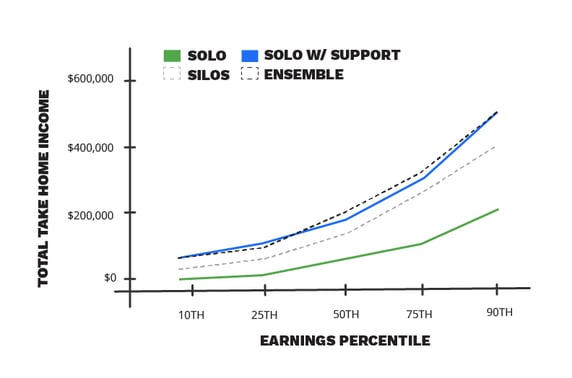5 Tips for Outsourcing Admin Support and Engaging with a Virtual Assistant
Share this
And it turns out that not doing it all alone makes sound business sense. Evidence from a 2018 Kitces Report suggests that financial advisors that outsource support have significantly higher revenue than financial advisors who do not.

This occurs for a variety of reasons. (I apologize if this is going to sound like your Economics course. Some of us can’t help it.)
Any time two individuals or firms have different opportunity costs to perform a task (the value of what they actually give up to do something – like spending more time with your clients), then they each have a comparative advantage over the other in something. This difference in the cost to perform a task incentivizes individuals and firms to specialize in what they can do at the lowest cost (i.e., what they have a comparative advantage in) so that they can trade for what they want. This has big implications. Just like it doesn’t make sense for most of us who want shoes to actually produce our own shoes, it doesn’t make sense for an advisor to engage in many tasks associated with their business. If you want more shoes, specialize in financial planning; if you want more revenue or time with clients, find your “Magic Sauce” and specialize in that – outsource the rest.
Here comes the hard part. These gains from trade happen even if you are better at everything than your support team. This is because the source of gains from trade comes from the different opportunities you give up to perform the task and not from an absolute advantage at production. As long as who you hire has a lower cost than you value your time, the advantages from trade will emerge.
But like all things, you have to know how to use this tool to your advantage. If you are considering engaging with outsourced support, here are five tips in order to avoid pitfalls, ensure success, and maximize your return on this investment.
#1: Have a plan for system access
There are two routes to take for getting a support person into your systems - creating a new login for them or having them piggyback into a system using your login credentials. It’s important to note that some systems prohibit sharing logins in their terms of service, so be sure to review your agreements with your vendors. We recommend having your support person have their own logins whenever possible as many systems require two-factor authentication (2FA), and having to rely on someone else for this can be tedious and requires coordination that often delays tasks. If you do share a login that requires 2fA, we recommend using a universal phone number that both you and your Virtual Assistant (VA) have access to or using an authentication app that allows you to connect to more than one device.
If you do decide to share login credentials, we recommend utilizing a password management tool, such as LastPass or 1Pass. Tools like these give you the ability to take control of your passwords by sharing them in a secure way, automatically updating passwords as they change, and allowing you to revoke passwords when that time comes. For similar reasons, we also recommend keeping a list of the systems that your support person has access to, along with any subscription charges you’re paying for them.
#2: Have a Knowledge Bank and do it the easy way
Although some VA services (like XYVA+) might be familiar with commonly used systems, most are not. If they are familiar with your systems, they’ll still need some guidance in order to follow your nuanced approach to things like prospect follow-up, client onboarding, and meeting prep and follow-up. This means that there are varying levels of training that you should expect to engage in when working with your support person or team.
Approaching this engagement with an understanding of the initial onboarding requirements is essential to your success. We have found the best outcomes occur when the advisor has been proactively creating meaningful training material to reference while engaging with support. The simplest way to build a Knowledge Bank of key tasks is to record yourself actually doing a few in a free system like Loom.com. Be sure to talk about any nuances, exceptions, and added tips while you are recording.
We have found that recording demos of key tasks is a far superior training approach compared to a reliance on workflows as a training tool. Although a good CRM workflow can be a useful way to delineate different portions of a larger task to different individuals and ensure consistency in client offerings, if you don’t currently use workflows, avoid spending excess time in their creation for training purposes. Although they are effective for usage once your support person has been trained, they do not tend to be effective training tools as they lack details and avoid most learners' optimal learning preferences.
In addition, since most administrative outsourcing services do not train VAs on your unique financial planning tech stack, it is likely you will need to do some basic training on how to use systems like Wealthbox, RightCapital, Orion, E-Money, WordPress, and other wealth management software systems. In these cases, the VAs learn best by watching training videos followed by imaginary case study modules in which they do tasks in a test environment and await your feedback on their efforts. Many systems offer great help docs that include starter videos for new users.
#3: Dedicate time for touchdowns and feedback
Again this might seem obvious but this is really important, and it is something many financial advisors don’t consider when they are planning their workload post-VA engagement. Although it is true that the total time required to onboard your outsourced support person is a fraction of what it would be to hire an employee, some time is still required to ensure any degree of success. As a rule of thumb, plan for 3-4 hours with your VA in the first few weeks for onboarding and one hour per week for the first few months. These times will vary based on what type of services you engage with. Ask us about how long XYVA+ takes.
If you are working with an outsourcing service in which you take the lead on training, the best course of action is for you to create a plan that starts with more frequent touchdowns and decreases as the person increases their familiarity with your RIA business. Although there are many ways to integrate feedback between yourself and your VA, it is essential to include semi-regular virtual meetings into your cadence and allow for screen sharing and demonstrations of tasks.
We recommend that during the interview process, you should ask questions about this person’s familiarity with the systems you use. Once you understand where they are, you can gauge how much time you will need to spend supporting them during their first 90 days in your RIA business. At a minimum, we recommend spending time considering their training needs, creating a curriculum using your Knowledge Bank, and then following up with them on a weekly basis with feedback on what they submitted. It is important to set your expectations realistically in those first few months as they get integrated into your process and understand your preferences. Building in time to learn, make mistakes, and integrate corrections is essential for a long and successful partnership.
#4: If this is an ongoing relationship, have a diverse set of tasks—recurring and long-term projects—to fill the hours and maximize your value
If you are going with an outsourcing service, we recommend one that begins by taking an in-depth look at your biggest pain points and where you envision your RIA business being in the future. This should provide the foundation for knowing what systems and processes are necessary to address those pain points and help you determine your expectations for your support team.
In preparation for engaging support, it is optimal for you to spend some time considering and ranking your pain points. As you engage with your support team, we encourage you to break potential tasks down into three categories - recurring, short-term projects, and long-term projects. Recurring tasks are what should drive at least 50% of your outsourced work. These types of tasks include client onboarding, meeting notes and email follow-up, custodian support, and data entry, to name a few.
The remaining time should be spent on short-term and long-term projects and to make progress towards some of those future goals that we established early on in the relationship.
#5: Believe in the value of your time
A DIY approach is great when you are on a tight budget and the opportunity cost of your time is relatively low. As you grow, the time you spend on tasks outside of your “Magic Sauce” – like operations and data entry – should decline. Anytime you are spending time outside of what you are really great at, it means you are sacrificing time with clients, prospects, and a work-life balance.
Let’s take the example of basic financial planning tasks like meeting notes and recaps. Assume it takes you 30 minutes to complete a task that we can do for you in one hour. Assume that you charge your client $250/hour while we charge you $70/hour. Finally, assume you choose to engage with us to perform this task for you. The outcome of you shifting your time towards what you have a comparative advantage in just resulted in you paying yourself $55 not to do the task. Not only that, but you also got 30 minutes of your day (which you value at $125) back to spend on what you do best: financial planning. This doesn’t just make good business sense. It means you get to spend more time doing what you love!
A final word of caution
Although there are many pitfalls you may be aware of when engaging with outsourced support, there are some pitfalls we see consistently that tend to trip up advisors. Here are some ways to avoid these and successfully integrate support for yourself and your clients.
Don’t assume your VA will be with you long.If you are working with a singular VA—and not a team-based solution—always prepare for the possibility of attrition, which is exceedingly high in this industry. According to a BLS report, approximately 38 percent of VAs leave their position within two years. Planning for this will make life less painful when it happens. As your VA accumulates skills and institutional knowledge, consider the importance of them investing in SOP creation and recordings.
Know Thy Vendor PolicyAs the Chief Compliance Officer and leader of your business, it is your obligation to know what data security policies exist for the vendors you work with. As many virtual assistant services 1099 their VAs, their cybersecurity and data protection policies vary widely. We strongly recommend doing your homework here by asking to see a Cybersecurity and NPI Protection Policy.
Often advisors focus on what type of password-sharing systems are used, but there is so much more that needs to be considered. Ask questions about whether the VAs work on company-issued laptops, what type of virus protection is used, VPN usage, and more is essential to protecting your client’s data.
It’s easy to forget that just because we can do it all doesn’t mean we should. Ask yourself what the value of your time is and what you give up when you do it all yourself. And the time does add up – offloading a mere 10 minutes a week adds up to an extra day off per year. Imagine what you can do with an extra 5 to 10 hours per week?
For fee-only financial planners, understanding and deploying these concepts can allow you to expand your practice while still maintaining the work-life balance you desire. Once you begin the process, it’s important to understand that the value from this investment takes a few months to truly be felt as your VA onboards into your system and learns your preferences. It is important to invest in this process and avoid common pitfalls.
 About the Authors
About the Authors
Monique Dutkowsky is XYPN's Vice President of XY Virtual Assistant+. She is an economist and former adjunct professor of economics at Montana State University. When she’s not playing with her three kids, she spends her time enjoying the beauty of Montana through trail running, backpacking, and skiing.

Stuart Pyne is XYVA+'s Onboarding Manager. In his role, he draws from his prior industry experience as a paraplanner and associate advisor to help XYPN members build their firms through outsourcing support and integrating best practices. During his free time, he enjoys playing golf, spending time with family and friends, checking out a new brewery, or working on a house project with his wife.
Share this
- Running Your RIA Efficiently: Outsourcing Bookkeeping with XYPN Books
- Road to Launch with XYPN Member Alan Skillern, CFP®, MBA
- Coaching for Better Time Management: Prioritizing Organic Growth in Your Daily Routine
- Boost Your Financial Advisory Practice: SEO Strategies and CRM Optimization for Sales Success
- Advisor Blog (693)
- Financial Advisors (221)
- Growing an RIA (99)
- Digital Marketing (87)
- Marketing (84)
- Community (81)
- Start an RIA (76)
- Business Development (72)
- Coaching (72)
- Running an RIA (70)
- Compliance (69)
- Client Acquisition (65)
- Technology (64)
- XYPN LIVE (59)
- Entrepreneurship (57)
- Sales (49)
- Practice Management (44)
- Client Engagement (41)
- Bookkeeping (38)
- XYPN Books (38)
- Investment Management (37)
- Fee-only advisor (36)
- Lifestyle, Family, & Personal Finance (31)
- Employee Engagement (30)
- Client Services (25)
- Financial Education & Resources (25)
- Journey Makers (21)
- Market Trends (21)
- Process (14)
- Niche (11)
- SEO (9)
- Scaling an RIA (9)
- Career Change (8)
- Transitioning Your Business (7)
- Partnership (6)
- Transitioning To Fee-Only (4)
- Social Media (3)
- Transitioning Clients (3)
- Emerald (2)
- Persona (2)
- RIA (2)
- Onboarding (1)
- Sapphire (1)
Subscribe by email
You May Also Like
These Related Stories

Say No to My Way or the Highway - What Would Arlene Say?
Sep 21, 2017
7 min read

Building Your Dream Team: A Pick-and-Choose Roster - What Would Arlene Say?
Feb 22, 2018
5 min read





